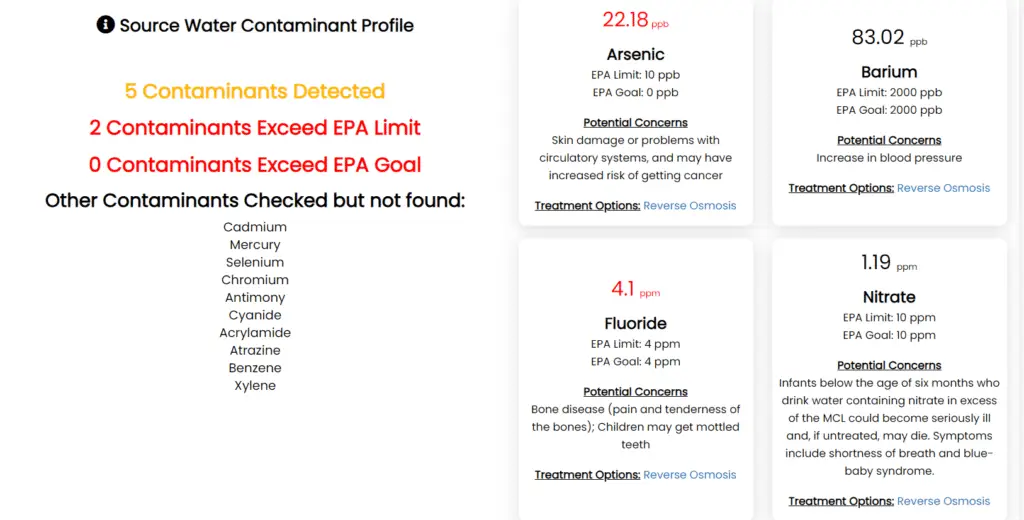How to Remove Fluoride from Drinking Water
- by Ryan Moreau / updated April 23rd, 2024
Fluoride is a naturally occurring mineral that most of us are exposed to daily through our drinking water and fluoride-containing dental products. Fluoridated water has long been used in public water systems in the United States since discovering the benefits of fluoride in preventing tooth decay in 1945. However, more recent studies have shown that excessive exposure to fluoride can lead to a range of health risks, including dental fluorosis, bone fractures, and even neurological damage. For this reason, many people are interested in removing fluoride from their drinking water.
There are several methods available for removing fluoride from drinking water, each with its own advantages and drawbacks. One of the most effective methods is reverse osmosis, which can remove up to 99% of fluoride from water. It’s important to note that removing fluoride from drinking water is not always necessary or recommended. The optimal level of fluoride in drinking water is around 0.7-1.2 mg/L, and levels above 4 mg/L are considered unsafe and in violation of the EPA’s maximum contaminant level.
Since fluoride is naturally occurring, unregulated private wells are at the greatest risk for high fluoride concentrations. Private well owners and public water supplies that source their water from groundwater should have an understanding of the average fluoride levels in their source water. To determine the average fluoride concentration in your source water, look up your local water quality report using our Taptool application. The good news is, if you’re concerned about the fluoride levels in your drinking water, there is filtration technology available that can remove it.

Contents
What is Fluoride?
Fluoride is an inorganic mineral compound composed of the naturally occurring element fluorine and one or more other elements. It is commonly found in varying concentrations in the earth’s crust throughout the world and is widely known to provide benefits to oral health by preventing tooth decay. Scientists stumbled upon this discovery when they realized that people who lived where drinking water supplies contained fluoride of 1 ppm or greater had fewer cavities than those who drank water with lower fluoride concentration.
Further studies showed that fluoride can prevent and even reverse tooth decay by inhibiting bacteria that produce acid in the mouth and by enhancing remineralization, the process through which tooth enamel is rebuilt after it begins to decay. In addition to building up in teeth, ingested fluoride accumulates in bones, providing further benefits.
Over the years, concerns have risen about some negative health effects of fluoride. Because of these negative health effects, the EPA regulates Fluoride in public water systems at a maximum contaminant level (MCL) of 4 ppm. If a public water system exceeds this level, they are in violation of the MCL, and corrective action must be taken to reduce these levels below 4 ppm.
How Does Fluoride Get Into Water
Fluoride enters our drinking water supply both naturally and by design through the process of fluoridation. Water fluoridation first started in the 1940’s in Grand Rapids Michigan, when they adjusted the fluoride content of the water to 1 ppm by adding sodium fluoride to the water. Today, approximately 75% of public water systems add fluoride to the water
Fluoride is also an abundant mineral in the earth’s crust. In areas where fluoride is naturally present in the soil and rocks, it can dissolve into groundwater and surface water. This can result in high levels of fluoride in drinking water sources, which can be harmful to human health.
Industrial processes, such as the production of aluminum, phosphate fertilizers, and glass, also contribute to increased fluoride levels in our drinking water. In these cases, fluoride is released into the environment through wastewater discharge and can contaminate nearby water sources. For information on local pollution in your local drinking water source, check out Taptool.
Health effects of Fluoride

Fluoride is a mineral that is commonly added to drinking water, toothpaste, and other dental products to prevent tooth decay and boost oral health. The Centers for Disease Control and Prevention (CDC) considers fluoridation of water one of the greatest achievements in public health in the 20th century.
While fluoride has benefits, excessive consumption can lead to health problems. Some of the potential health problems that can arise from excessive fluoride consumption include:
- Skeletal fluorosis: a condition that affects the bones and joints, causing pain and stiffness.
- Fractures: excessive fluoride consumption can lead to weakened bones and an increased risk of fractures.
- Thyroid problems: high fluoride levels can interfere with thyroid function, leading to thyroid problems.
- Reproductive problems: high levels of fluoride may affect reproductive function and lead to fertility problems.
- Neurological issues: some studies have suggested that excessive fluoride consumption can affect brain function and lead to neurological problems.
- Tooth and bone damage: excessive fluoride consumption can damage tooth enamel and bones.
- Skin problems: some people may develop skin rashes or other skin problems from excessive fluoride consumption.
- Cardiovascular issues: some studies have suggested that excessive fluoride consumption may increase the risk of cardiovascular disease.
According to the World Health Organization, excessive fluoride intake usually occurs through the consumption of groundwater that is naturally rich in fluoride or where high-fluoride water is used in food preparation or irrigation of crops. Exposure in this way is what typically leads to some of the more negative health effects of fluoride. The World Health Organization estimates that excessive fluoride concentration in drinking water has caused tens of millions of dental and skeletal fluorosis cases worldwide over a range of years.
Although removing fluoride from drinking water may be difficult and expensive on a large scale, low-cost filtration options can be used to reduce the levels at home.
How to Test for Fluoride in Water at Home
If you want to know how much fluoride is in your drinking water, you can test it easily at home using some simple test strips. Water testing is extremely important if you own a private well because the EPA does not monitor wells. It is commonly recommended to have your well tested annually for various contaminants, including fluoride. While test strips are great for a quick and dirty idea of the fluoride levels in your water over time, more accurate levels can be measured by sending your samples off to a certified lab like Simplelab.
It is important to note that fluoride levels can vary daily, so it is recommended to test your water regularly, especially if you have concerns about the fluoride levels in your area. If testing shows that the fluoride levels in your water are elevated to close to 4 ppm or above at any time, you may want to consider some filtration options.
Water Filters that Remove Fluoride
There are several effective methods for removing fluoride from drinking water at home. Here are some of the most popular methods:
Reverse Osmosis
Reverse osmosis (RO) systems are one of the most effective ways to remove fluoride from water. They work by forcing water through a semipermeable membrane that filters out impurities, including fluoride. Reverse osmosis systems can remove up to 99% of fluoride from water. A reverse osmosis system is most commonly used as point-of-use filtration and is typically installed under the sink or on the countertop.
Activated Alumina
Water filters that use activated alumina are also effective at removing fluoride from water. Activated alumina filters work by adsorption of fluoride ions. These filters are used specifically for fluoride and arsenic removal and are most commonly installed under the sink or as a whole house system. The removal rate of fluoride depends on the pH of the incoming water and flow. Unfortunately, for optimal fluoride removal rates, the pH and flow rate requirements are lower than ideal. The fluoride removal rate can be as high as 95%, but this is at a very low and corrosive pH of 5.5. For point-of-use systems, it’s best to stick with an RO system. Activated Alumina systems are best used as a whole-house option since whole-house RO systems are very expensive. They also may be a good option if you want to reduce fluoride levels but keep some in the water for oral health.
Distillation
Distillation is another effective method for removing fluoride from water. It works by boiling water and then condensing the steam back into liquid form, leaving behind impurities like fluoride.
Bone char carbon Filters
Standard carbon filters are not effective at removing fluoride from water. However, some specialized carbon filters, like Brimac Char filters, can remove fluoride.
Does Boiling Water Remove Fluoride?
Boiling water will actually increase the concentration of fluoride. When you boil water, pure water escapes as steam and the fluoride will remain behind in the water, effectively reducing the total water and increasing the concentration of the remaining fluoride.
Does Bottled Water Contain Fluoride?
Some bottled water companies use water sources that naturally contain fluoride, so their bottled water may naturally have low fluoride levels. Other bottled water brands use advanced filtration processes that can remove most, if not all, of the fluoride from the water.
If you want to know whether a specific bottled water brand contains fluoride, you can usually find this information on the water bottle label or the manufacturer’s website. It’s also worth noting that some bottled water brands may offer both fluoridated and non-fluoridated options, so you can choose the one that suits your preferences.
In general, the fluoride content in most bottled water is significantly lower than what you might find in tap water in areas where water is intentionally fluoridated for dental health purposes. If you’re concerned about fluoride in your drinking water, it’s a good idea to check the label or contact the manufacturer for specific information about the fluoride content in the bottled water you’re considering.
How Do I know if my Water Contains Fluoride
If you are on city water, you can check if your water is fluoridated using a tool provided by the CDC, My Water’s Fluoride. If your water is not fluoridated or you are on a well, check out our taptool application to see the average fluoride concentration in your area. Enter your zip code and look at your source water contaminant profile in your report. If you are on well water, make sure you select well water from the dropdown menu on the application.
Below is an example Taptool report showing very high fluoride levels and arsenic levels in city water that draws from a groundwater source. The levels shown in the source water in this example exceed the EPA’s Maximum Contaminant Level of 4 ppm. Compare your local water quality results with your public water systems consumer confidence report and conduct additional testing as needed to verify the levels. This will help you make an informed decision if additional filtration is necessary.
If you have any further questions about fluoride in water, please feel free to Contact Us.

